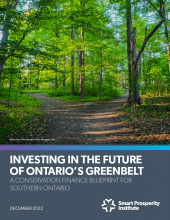Canada is leading the way to build support for protecting 30% of global lands and oceans by 2030. To achieve this ambitious goal, urgent policy action and new financial models are needed to accelerate investments that conserve and restore natural ecosystems.
Nowhere is the urgency greater than Ontario’s Greenbelt. Generating $3.2 billion of value every year from water supply, agriculture, outdoor recreation, clean air, and flood protection, ecosystems in the Greenbelt are some of the highest valued in Canada. Unique natural landscapes and productive agricultural lands have long supported regional growth and prosperity, but consistent pressures from regional development are placing a strain on the ability of these ecosystems to sustain future growth.
Advancing conservation finance projects in the Greenbelt will be necessary to increase investments in nature that are able to provide both ecological and financial returns and support long-term regional prosperity.
Smart Prosperity is excited to launch Investing in the future of Ontario’s Greenbelt: A conservation finance blueprint for Southern Ontario, a first of its kind in Canada, to help guide stakeholders with accelerating the development of world-class conservation finance projects in the Greenbelt.
Key messages
Investing in Greenbelt ecosystems offers several low-risk, high-reward opportunities to enhance key regional ecosystems, generate economic value for local communities, and reduce the risk of costly environmental impacts. A few immediate opportunities include:
- Investments in near-urban ecosystems to reverse habitat loss and improve the resilience of more than 3 million households. These ecosystems are highly productive, contributing $509 million annually to regional GDP, but are also some of the most under threat.
- Investments in new large-scale parks and improvements to manage existing outdoor recreation areas. The Greenbelt has the highest recreation demand in Canada, generating more than $2.1 billion annually. By 2051, a minimum of 32,000 ha of new parkland will be needed to maintain per capita levels.
- Investments in forest and wetlands to reduce the impacts of climate change and improve the mitigation capacity of regional ecosystems. The Greater Golden Horseshoe is considered ‘shovel-ready’ to plant 54 million trees on 54,000 ha, providing substantial carbon storage benefits, cleaner air, greater flood mitigation, and a reduction in exposure to extreme heat.
- Investments in regional farmlands to support continued local food production and tourism opportunities. Sectors that are directly linked to the integrity of these ecosystems, such as agriculture, agri-food, tourism, and outdoor recreation, contribute more than $2.9 billion in annual revenues.
Conservation finance projects can help build long-term regional prosperity by unlocking the value of natural assets to increase greater public and private investments in nature. Our Blueprint highlights a few of these opportunities:
- Insurance products to incentivize investments in nature-based infrastructure. Public and private land in the Greenbelt is vulnerable to an increasing number of economic losses and liabilities due to climate change. Calibrating insurance products to incentivize investments in climate resilient infrastructure presents a clear opportunity to minimize future risks.
- Recreation bonds to improve the health and well-being of local communities. More work is needed to connect conservation and restoration to specific health outcomes in the Greenbelt, but there is significant potential to design conservation finance projects using health-based value streams.
- Resilience bonds to mitigate flooding and improve source water protection. These types of projects can generate significant revenue streams by boosting the value of key economic sectors and helping municipalities avoid costly infrastructure upgrades and recurrent damage from flooding.
- Revolving funds to help mitigate the impact of habitat loss on ecological function and economic productivity in the Greenbelt. With diverse ecosystems in the Greenbelt already generating substantial revenues from tourism and agriculture, a coordinated approach could represent an opportunity to develop further low-risk, high-impact investments at scale.
- Carbon offset potential in regional forests. With 120,000 hectares of forest cover in the Greenbelt, using a voluntary offset protocol, revenues from a carbon offset project could amount to an additional $17 million in annual revenues.



